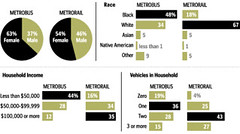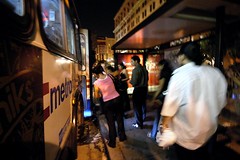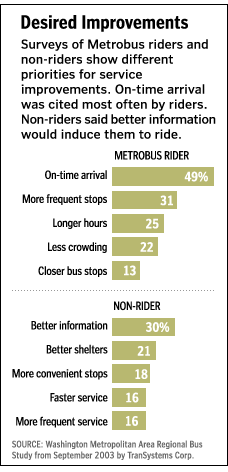How do we encourage people to use different forms of transport?

Transit rider demographics, Washington DC region. Washington Post graphic.
C4bl3Fl4m3 (Cableflame) wrote a long response to an earlier entry today, and it deserves wider readership, so I am extracting and reprinting it. I will say that I think that it's not just "making transit cheap, efficient, convenient & easy-to-use," it's also making driving more expensive, less efficient, less convenient, and harder to use."
Most transportation and land use planning decisions cater to drivers. I take the hard core position because most people argue so vociferously in favor of the car.
Here goes:
Ok, it's pipe dream time.
By making transit cheap, efficient, convenient & easy-to-use. The best solution will not be a 1 or 3 "things different" solution, but a wide variety of changes all working together towards a common goal.
Under cheap goes reasonable fares, but also goes cheap parking at suburban stations.
Yes, I know that we're supposed to be discouraging the use of the car, but if you want people to take Metro, you need to make it cheaper to park at Greenbelt (or Shady Grove or where ever) and take the Metro in than it is to drive downtown and park there.
-------------
I think the response is how to make it easy and cheap to get to subway stations, without necessarily encouraging driving. Having a car sit in a WMATA-built and paid for and maintained parking lot or structure is a lousy use of transit system capital. Better that people get shuttled to transit systems by deep and convenient bus systems from stops located an easy walk from home--how it's done in Montgomery County for example. Although people have complaints about frequency, especially outside of rush periods.
See these early blog entries from March 2005:
-- Dr. Transit's Prescription for Fairfax County Transportation Planning: More Openness, More Creativity
-- Maybe the Virginia Railway Express and Fredericksburg can learn from Ride On?
---------------------
Yes, I know that advocates of transit are usually some form of anti-car, but we're not going to get people to give up their cars 1.) by making them pay MORE to take transit and 2.) by not easing them into transit. The better solution is to give incentives to take transit (cheaper than driving) and to encourage them to give up their cars by gradually easing them into taking transit. Start with part of the trip, work towards the entire trip. (Yes, I know, we urban folks don't want to subsidize suburban usage of transit. But let's be honest... do we want them to take transit or not? If so, it's time for us to put our money where our mouth is.)
-----
It's good to subsidize transit, regardless of location... remember that roads are subsidized to the tune of 50% too.
-----
Yes, I know that we like to promote urbanity and discourage suburban life on this blog, but we need to be realistic... many MANY people live in the suburbs and it's those people that are (probably) doing the most driving. And telling them to move to the city and sell their car is asking for too radical of a change. Baby steps, everyone.
Let's see. Other things that need to change. Clear information about DC's busses. I'm a regular bus user and even *I* don't have my head wrapped around our bus system. I'd love to know how to get to, say, Gallery Place/Chinatown from Dupont Circle via bus. The WMATA Ride Guide is one of the best things since sliced bread. I have no idea how people in other cities with extensive bus systems survive w/o it. (I'm looking @ NYC, Seattle, and even Rochester.) Also, the new bus maps in the shelters are a start, but I find them confusing... and, once again, I'm good at using transit information. (I think that the Commuter Store really has the right idea when it comes to transit info. I just wish that they existed for DC and MD).
If you want more people to take the bus, you need to have the busses actually run on time. I can't take the 70/71 to Silver Spring from Juniper St NW and Georgia Ave NW if I need to get somewhere at a certain time because it RARELY is on time. Part of what's needed for this is a revamping of the schedule to reflect actual arrival times and also what's needed is greater instruction on proper usage of the bus. (So many times have we been held up by a passenger trying to dig money out of their pockets or by a prospective passenger trying to convince the bus driver to let them on w/o proper fare.)
-------
I have been riding the bus more lately and I find it a very interesting experience from an ethnographic standpoint. There is a greater likelihood of kinship systems developing on buses, especially if you ride the same bus and begin recognizing people. People are more likely to offer directions without your asking if they overhear you mulling how to get somewhere. The bus drivers are more likely to let someone slide on a quarter if they are short (at least in the NE quadrant/PG County buses).
(This all reminds me of the discussion of use value of place in Logan and Molotch's Urban Fortunes. See "Highest and best use" where I list the six use values of place that they outline.) This rarely happens on the subway.
-------

Washington Post photo by Gerald Martineau.
The people who ride the busses I ride most of the time are poor people of color. It seems that the bus in America is thought of as what the poor people use... it's thought of as lower class transportation. We need to work to get past that image, and part of that work is to actually have the bus 1.) be well taken care of/be clean and 2.) arrive on time. The ad campaign with one of the well known writers for the Post saying "Why do I take the bus? Have you seen me drive?" was a start, but that's it. A START. Middle and upper class people won't take the bus if it's inefficient, unreliable or unclean. Make these things your top priority and ridership WILL go up.
And back to the poor people and the holdups because of people not having fare/trying to dig their fare out. I've noticed that most poor people don't have a SmarTrip card. Perhaps they can't afford the $5. But I've found that the SmarTrip card can actually HELP when you're low on cash. 1.) it'll automatically give you a transfer if you're still within transfer time, limiting the times you pay when you really don't need to (if you say that the paper transfers usually give you more time [and I've found they can], fine, ask for a paper transfer too) and 2.) you can go into a negative balance with them. Handy when you only have 30 cents and you still need to take the bus to work.
These are distinct advantages for poor people... and yet, I don't see them being marketed to poor people. I also don't see any information on SmarTrip in other languages, like Spanish or French or Korean or Chinese. (I could be missing that, however. Correct me if I'm wrong.) If everyone got a SmarTrip card, it would certainly help out a lot of people, as well as it would make boarding the bus MUCH faster (and would probably help the 70 /71 run closer to on time, too). If Metro (or other pro-transit organizations) was serious about getting poor people to use SmarTrip, they could offer subsidized cards and/or have a period where they give out free cards.
------
Good points. Instructions on London's Oyster Card are offered in 12(!) languages: Arabic, Bengali, Chinese, French, Greek, Gujarati, Hindi, Punjabi, Spanish, Turkish, Urdu and Vietnamese! And when Chicago ended their system of paper transfers, they offered smart cards for free for a certain period of time for this reason.
------
Another way to get people to use transit is better bike lockups in more locations. I don't know WHO designed those bike racks, but they're a horrible design. Because I'm a small woman (5'1"), I use a youth bike. My bike doesn't fit properly in those racks. Also, I was reading how to use them properly to lock down your bike, and you're supposed to use a standard padlock. I know of NO ONE who uses a standard padlock to lock down their bike... everyone has either a cable lock or a U style lock. And how about making the bike lockups be in a sheltered place not too far out of the station and public view? It would discourage crime.
Oh, and better service to the far off suburbs (Howard County, Anne Arundel County, etc.) would be nice. Commuter service is ok, but have reverse commuter service too. And if you REALLY want to have people use transit, run it late into the evening so that people who go into the city for nightlife can use transit to get them back and not just there.
Oh, and that thing about nightlife service? That applies to more than just far off suburb service. That applies to everything. You want people to take Metro to their destination? Have Metro still run to take them home when they get out of the club at 4 am.
I guess in short, transit needs to have more of a "use-centric" view. Figure out what uses people would have for transit, figure out what it would take to get them to use transit for those uses (efficiency, ease-of-use, reliability), and then give it to them. And if you're serious about getting suburban ridership, then you have to give the suburbs a good reason to use transit. 'Cause suburban minded people are also car minded people. They don't give up using their cars easily. You have to make the alternative even better.

Index Keywords: transit



0 Comments:
Post a Comment
<< Home